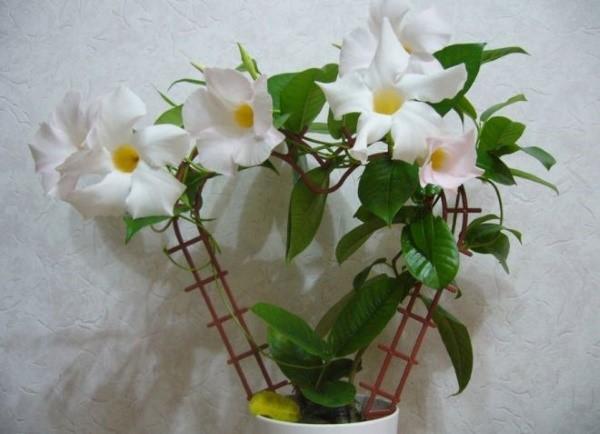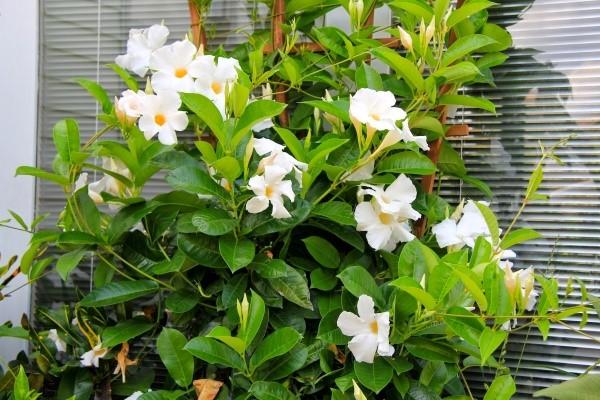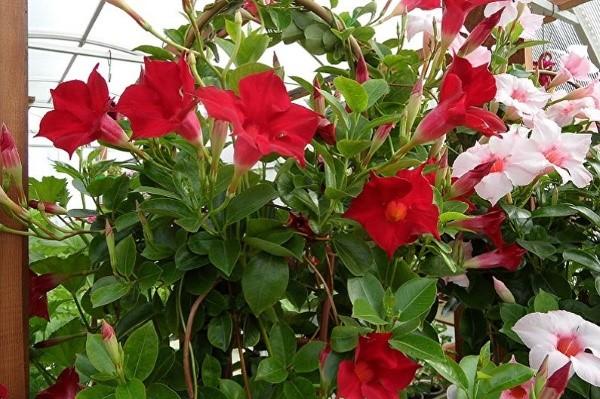Home care for diploma - growing a capricious Tropicana
 Are you interested in plants with "character"? Then taking care of your diploma at home can fully satisfy your curiosity. Not many people undertake to grow this plant, because the tender liana is not one of those crops that you can forget about after planting. Coming from the humid tropics, it requires a special approach as a house plant. But on the other hand, this flowering liana compensates for the excess of attention to itself with abundant and long flowering. What does a bright beauty need so that she remains so elegant for a long time and blooms every year?
Are you interested in plants with "character"? Then taking care of your diploma at home can fully satisfy your curiosity. Not many people undertake to grow this plant, because the tender liana is not one of those crops that you can forget about after planting. Coming from the humid tropics, it requires a special approach as a house plant. But on the other hand, this flowering liana compensates for the excess of attention to itself with abundant and long flowering. What does a bright beauty need so that she remains so elegant for a long time and blooms every year?
For the luxurious flowering, the flower growers have given the diploma many delicate "nicknames". Among them the most popular are Chilean jasmine, Bolivian rose, Brazilian balsam, Mexican tree of love.
Description of the plant

Dipladenia is a poisonous plant, and the milky sap causes burns. Any procedures during which there is a need to touch the flower must be carried out with gloves.
Glossy leaves on long curly shoots look beautiful themselves. However, the true "essence" of diplody appears during flowering. Not only is it very long lasting. The first buds appear in early spring, and the last ones bloom in late autumn. In addition, rarely any plant has so many flowers. An adult bush of diplodenia, flowering for more than one season, can produce up to 80 buds at a time. Moreover, each of them lasts up to 2 weeks.
 Separately, it should be said about the colors themselves. They are large, up to 10 cm in diameter, tubular in shape and have a bright color. Depending on the specific variety, it can be either delicate white or pink inflorescences, or rich burgundy buds. The flowers consist of 5 petals, tapering towards the edge, and in almost all species they give off a sweet aroma.
Separately, it should be said about the colors themselves. They are large, up to 10 cm in diameter, tubular in shape and have a bright color. Depending on the specific variety, it can be either delicate white or pink inflorescences, or rich burgundy buds. The flowers consist of 5 petals, tapering towards the edge, and in almost all species they give off a sweet aroma.
The name of the plant is translated as "two-iron". Dipladenia on stamens has two honey glands, which served as the basis for the name of the culture. In the scientific literature, the flower is still often found under the name of Mandeville. He received it thanks to an English diplomat who was fond of gardening.
Indoor conditions for diplomatic life
Since the plant is home to the hot and humid tropics, it is not surprising that indoors it begins to be capricious. In order for a vine to really actively branch and bloom profusely, it needs to provide conditions as close as possible to natural ones. First of all, this applies to lighting, temperature and humidity.
How much light does a diplomacy need
 The rich color of the deciduous head and the abundance of flowering directly depend on the lighting. Liana needs bright, but diffused lighting.A flowerpot can be placed on the south window only if the diplomatic property is protected by a curtain in the afternoon. Otherwise, the rich color of the leaves burns out, burns appear on them, and the buds crumble.
The rich color of the deciduous head and the abundance of flowering directly depend on the lighting. Liana needs bright, but diffused lighting.A flowerpot can be placed on the south window only if the diplomatic property is protected by a curtain in the afternoon. Otherwise, the rich color of the leaves burns out, burns appear on them, and the buds crumble.
It is quite natural that the northern window will not suit a tropical guest either. There is too little light for her, which will lead to stretching of the branches. Also, with poor lighting, the flowering itself suffers, reducing the number of ovaries.
The east and west windows are just what Mandeville needs.
 For the summer, a pot of liana can be taken out on balconyprovided it is shaded. Diplomacy loves fresh air, but not drafts. In a private house, you can move a bush to a summer terrace, choosing a cozy, not ventilated corner for it.
For the summer, a pot of liana can be taken out on balconyprovided it is shaded. Diplomacy loves fresh air, but not drafts. In a private house, you can move a bush to a summer terrace, choosing a cozy, not ventilated corner for it.
Air humidity is an important condition for diploidia
Like any tropical inhabitant, the vine is demanding on air humidity, especially during flowering. In a house, such indicators as in nature are almost impossible to achieve, especially during the heating season. The best option is to put the flowerpot in a tray filled with wet pebbles. And, of course, spray the bush regularly.
Features of the temperature regime
 Mandeville is one of those plants that are not afraid of high temperatures. On the contrary, in a hot summer in a darkened place, its color only becomes brighter and richer. However, do not forget that in our conditions in winter daylight hours become significantly shorter. Diplomacy ceases to bloom and goes into hibernation, suspending its development. For this period, the temperature in the room should be no higher than 15 °, but not lower than 12 ° heat.
Mandeville is one of those plants that are not afraid of high temperatures. On the contrary, in a hot summer in a darkened place, its color only becomes brighter and richer. However, do not forget that in our conditions in winter daylight hours become significantly shorter. Diplomacy ceases to bloom and goes into hibernation, suspending its development. For this period, the temperature in the room should be no higher than 15 °, but not lower than 12 ° heat.
Another interesting feature of growing a diplodenia flower is the ability to extend flowering. If you do not lower the temperature, but keep it around 25 ° C all year round, the vine will bloom throughout the year. But for this you also need to provide the plant with 14-hour daylight hours. For this, special lamps.
Soil for Diploma
 Growing and caring for a diploma also implies a properly selected soil. Blooming liana is demanding on the composition of the soil. It should be fertile, light and sour. For rooting cuttings, you can use a clean peat... For an adult plant, more nutritious soil is needed, but the presence of peat in it is mandatory.
Growing and caring for a diploma also implies a properly selected soil. Blooming liana is demanding on the composition of the soil. It should be fertile, light and sour. For rooting cuttings, you can use a clean peat... For an adult plant, more nutritious soil is needed, but the presence of peat in it is mandatory.
Such a soil mixture is not difficult to prepare on your own by mixing in equal parts:
- peat;
- sand;
- humus;
- sod land.
Perlite can be added instead of sand.
Home care for diploma
 As you can see, creating comfortable conditions for it is of paramount importance for growing tropical liana.
As you can see, creating comfortable conditions for it is of paramount importance for growing tropical liana.
In the future, it remains only to support them, and provide the plant with adequate nutrition, namely:
- Watering. During the flowering period, the vine needs frequent and abundant soil moisture. In spring and autumn, it is necessary to water the bush at least twice a week. In hot summer, you need to monitor the moisture content of the earth daily and water it as soon as it dries up to 1 cm deep. In winter, watering is reduced. The water should be warm, settled, without lime admixture. But adding a little citric acid once a month does not hurt.
- Spraying. Moisturizing the crown will help diplodenia maintain the necessary moisture.
- Top dressing. As a flowering plant, Mandeville needs additional fertilization. This should be done only from the beginning of spring to the end of summer, using liquid preparations. During the rest period, the bush does not need feeding. At the beginning of spring, when the active growth of new leaves begins, nitrogen fertilizers need to be applied several times. With the beginning of the formation of buds, you should switch to potassium-phosphorus preparations.
- Establishing support. Dipladenia shoots are long and rather fragile. To prevent them from breaking, it is advisable to install a special ladder in the pot. Support is required even if the Mandeville grows as a bush.
- Pruning.Liana grows very quickly, releasing new shoots and pulling out last year's branches. It is important not to miss the moment when to cut off the diplody. This should be done after the end of flowering, shortening those branches that did not have time to bud in the current season. No more than 1/3 of the escape is left. Older stems can also be shortened slightly to give the plant the desired shape.

- Transfer. It should only be carried out when the bush has clearly grown out of the pot, as evidenced by protruding roots. In an adult large Mandeville, it is enough to replace the topsoil.
When starting pruning, it is necessary to take into account that the flower buds of the diplodemy are laid only on young growth. A cardinal cut will affect the flowering next season, significantly reducing the number of buds. It is better to slightly update the bush, and lay long branches around the support.
Home care for diplomas in winter
 Under natural conditions, the vine is capable of blooming continuously throughout the year. As a room culture for the winter, it leaves for forced rest. This is due to a significant reduction in daylight hours. In order for the wintering to be successful, it is necessary to prune in early November and reduce the frequency of watering. Spraying and feeding is stopped until spring.
Under natural conditions, the vine is capable of blooming continuously throughout the year. As a room culture for the winter, it leaves for forced rest. This is due to a significant reduction in daylight hours. In order for the wintering to be successful, it is necessary to prune in early November and reduce the frequency of watering. Spraying and feeding is stopped until spring.
For the winter, the pot with dipladenia must be moved to a cool room, but not to the window. There is a risk that the soil will be overcooled, and this will lead to the death of the plant.
Cool room means just coolness, not sub-zero temperatures. The winter temperature regime for keeping creepers should be within 12-15 ° C. If the leaves of diplodenia turn yellow and fall off, this may just be the result of the fact that she is cold. In summer, the vine gives a similar reaction to excess or lack of moisture.
Reproduction of diploania
 You can get new plants of tropical liana using seeds or cuttings. Sowing seeds can be started traditionally in spring, in March, using a peat substrate and a greenhouse. They sprout long enough and sometimes the first shoots appear only after 4 months. To speed up this process, you can soak the seeds in a growth promoter before sowing. Diplomination begins to pick seedlings when a pair of true leaves is formed in the seedlings.
You can get new plants of tropical liana using seeds or cuttings. Sowing seeds can be started traditionally in spring, in March, using a peat substrate and a greenhouse. They sprout long enough and sometimes the first shoots appear only after 4 months. To speed up this process, you can soak the seeds in a growth promoter before sowing. Diplomination begins to pick seedlings when a pair of true leaves is formed in the seedlings.
Terry varieties of Mandevilla are most often grown by the seed method. Cuttings of this variety are extremely reluctant to root.
 Reproduction of diplopia by cuttings is a more popular method that will allow you to see the flowering of vines in the first year. Cuttings can be harvested from April to July, using young tops or stems from lignified stems. They take root in peat (under the film) or first in water with further transplantation.
Reproduction of diplopia by cuttings is a more popular method that will allow you to see the flowering of vines in the first year. Cuttings can be harvested from April to July, using young tops or stems from lignified stems. They take root in peat (under the film) or first in water with further transplantation.
Summing up, I would like to note that some of the features of care for diploma at home are actually not so scary. These are just the points that you should pay attention to initially. But as a result, the tropical liana will delight you with an abundance of chic buds until late autumn. Try it and let it work out for you!